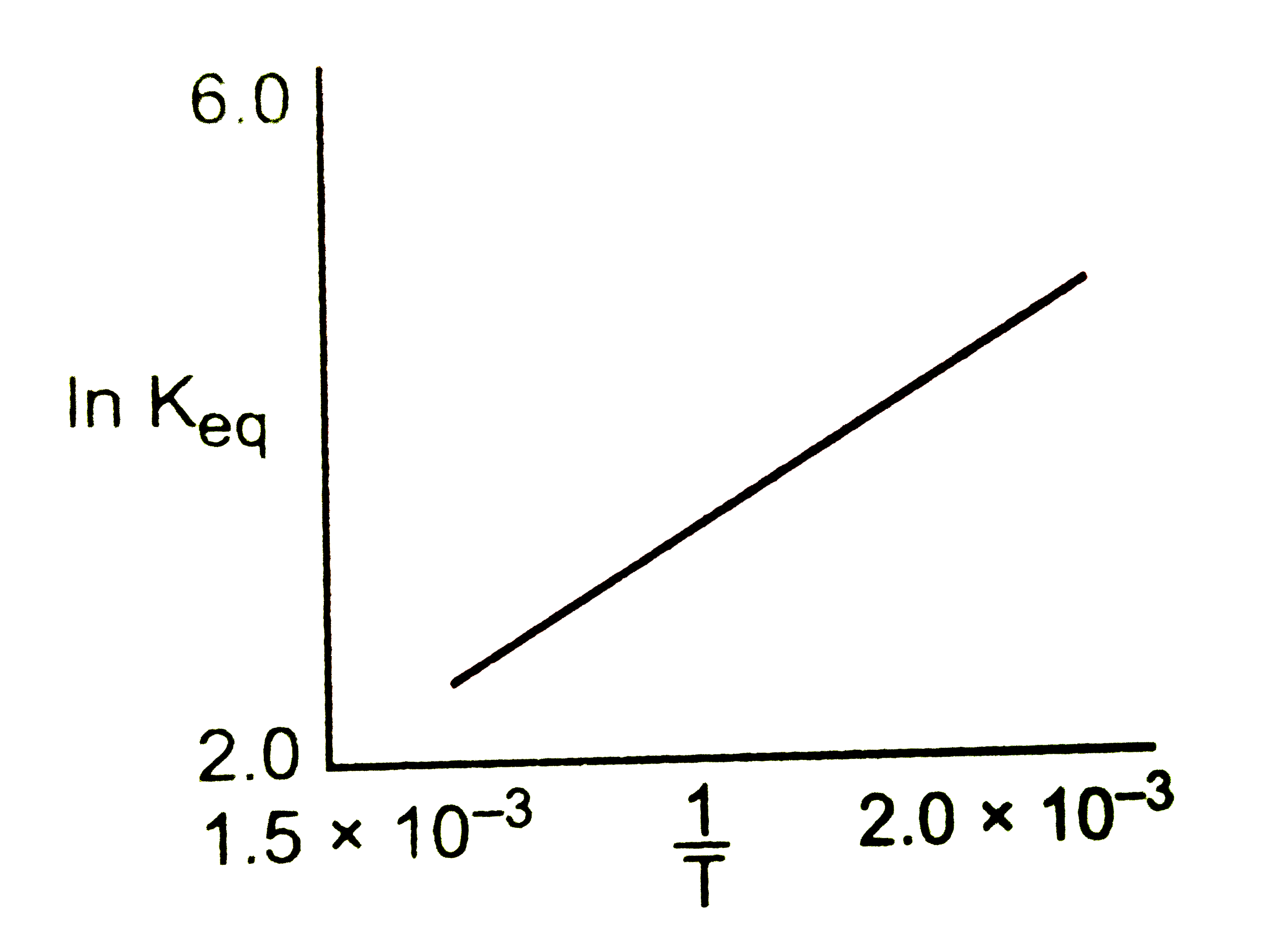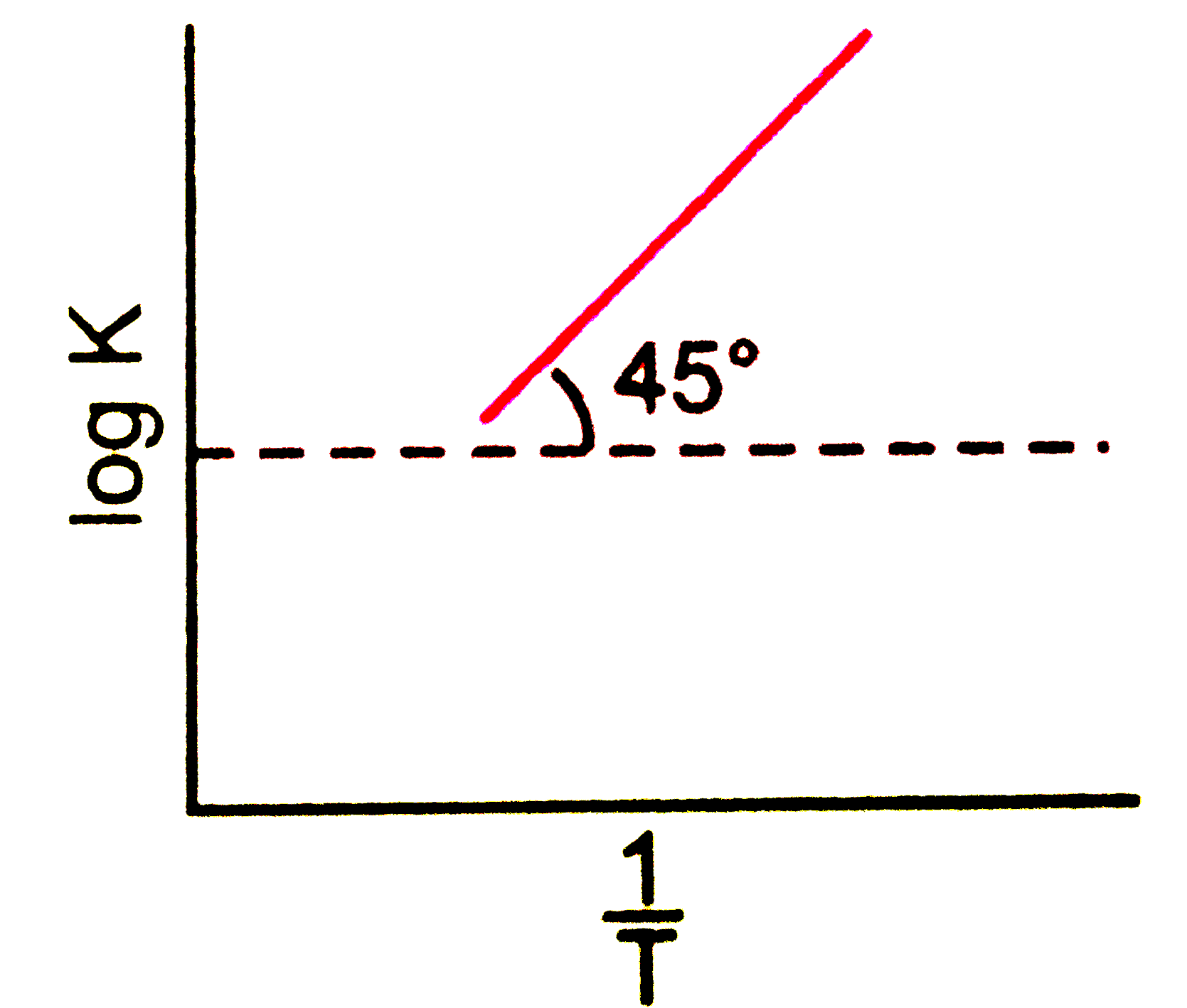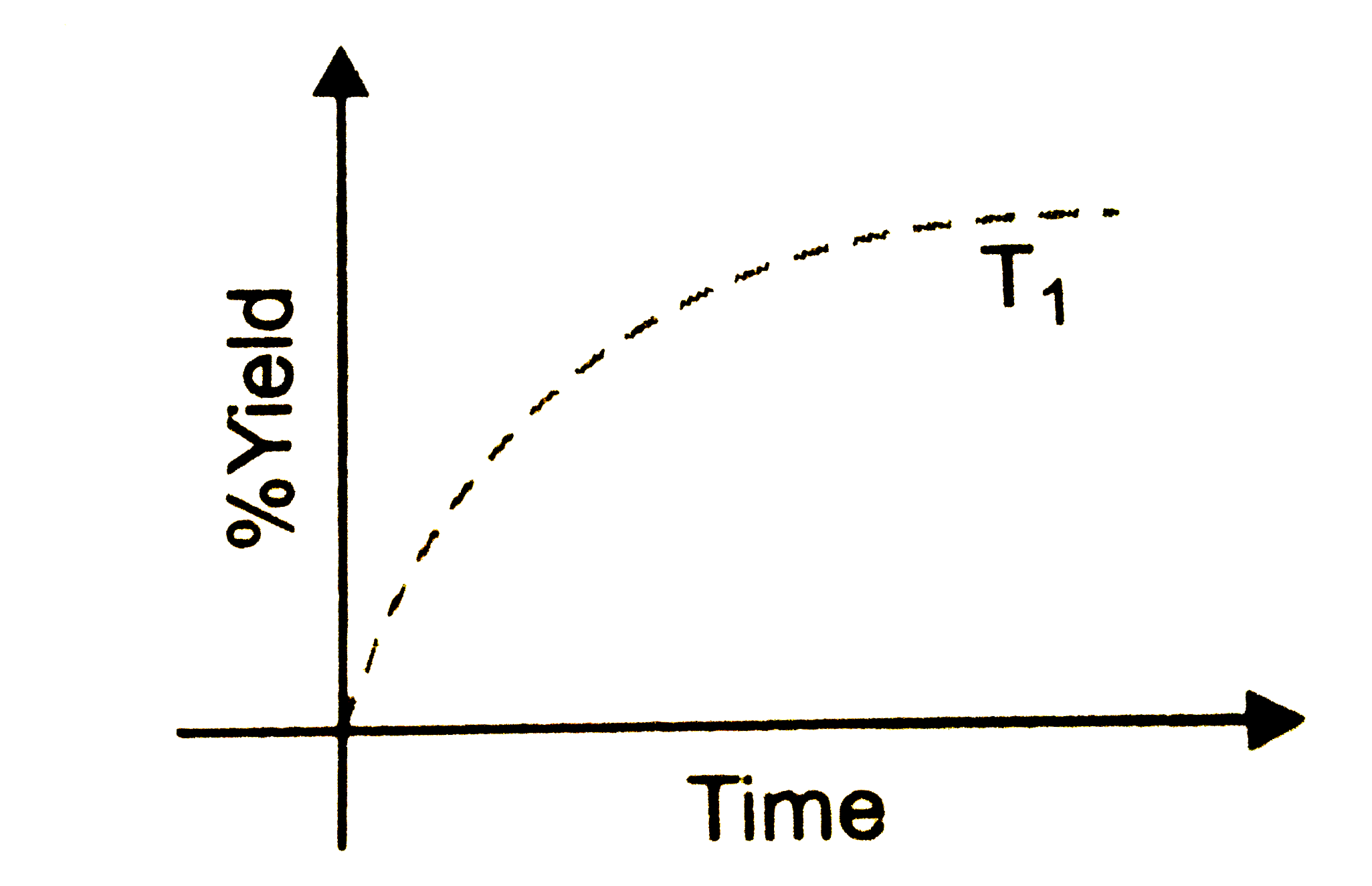Complete Solutions to Competition Focus (Jee(Main and advanced)/Medical Entrance) I. MULTIPLE CHOICE QUESTIONS (with one correct answer) of chapter EQUILIBRIUM IN PHYSICAL AND CHEMICAL PROCESSES of Class 11 book with complete answers and questions
| Class 11 | CHEMISTRY |
| Chapter | EQUILIBRIUM IN PHYSICAL AND CHEMICAL PROCESSES |
| PRADEEP | Competition Focus (Jee(Main and advanced)/Medical Entrance) I. MULTIPLE CHOICE QUESTIONS (with one correct answer) |
| Number Of Questions | 75 |
| Academic Year | 2023-24 |
The vapour pressure of a liquid in a closed container depends upon
View SolutionFor the synthesis of ammonia by the reaction `N_(2)+3H_(2)hArr2NH_(3)` in the Haber's process ,the attainment of equilibrium is correctly predicated bt the curve
View SolutionFor the reversible reaction
`N_(2)(g)+3H_(2)(g) hArr 2NH_(3)(g)`
at `500^(@)C`, the value of `K_(p)` is `1.44xx10^(-5)` when the partial pressure is measured in atmosphere. The corresponding value of `K_(c)` with concentration in mol `L^(-1)` is
View SolutionThe temperature at which `K_(c) and K_(p)` will have the same value for the equilibrium ,
` N_(2) O_(4) (g) hArr 2 NO_(2) (g) ` is
View SolutionThe pressure at which equilibrium constant in terms of pressures is found to be equal to that in terms of mole fraction for the equilibrium,
` PCl_(5) (g) hArr PCl_(3) (g) + Cl_(2) (g) `
View SolutionWhite solid balls of naphthalene `(C_(10)H_(8))` used as moth balls were kept in a closed container at room temperature `(27^(@)C)` . The vapour pressure above the balls was found to be 0.10 mm Hg. The value of `K_(c)` for the sublimation equilibrium ,
` C_(10)H_(8) (s) hArr C_(10)H_(8) (v) ` is
View SolutionFor the reaction, `SO_(2)(g) + (1)/(2)O_(2)(g)hArrSO_(3) (g)`, If `K_(p) = K_(c) (RT)^(x)` where the symbols have usual meaning then, the value of x is (assuming ideality).
View SolutionFor the reaction
`CO(g)+CI_(2)(g)hArrCOCI_(2)(g)`
`K_(p)//K_(c )` is equal to
View SolutionThe equilibrium constant `K_(p)` for the reaction `H_(2)(g)+I_(2)(g) hArr 2HI(g)` changes if:
View SolutionGiven : ` 2 N_(2) O (g) hArr 2 N_(2) (g) + O_(2) (g) , K= 3*5 xx 10^(33)`
` 2 NO _(2) (g) hArr N_(2) (g) + 2 O_(2) (g) , K= 6*7 xx 10^(16)`
` 2 NO (g) hArr N_(2) (g) + O_(2) (g) , K= 2*2 xx 10^(30)`
` 2 N_(2)O_(5) (g) hArr 2 N_(2) (g) + 5 O_(2) (g), K+1*2 xx 10^(34)`
Which oxide of nitrogen is most stable ?
View SolutionThe equilibrium constant for the reaction
`N_(2)(g)+O_(2)(g) hArr 2NO(g)`
at temperature T is `4xx10^(-4)`.
The value of `K_(c)` for the reaction
`NO(g) hArr 1/2 N_(2)(g)+1/2 O_(2)(g)`
at the same temperature is
View SolutionIf the equilibrium constant for
`N_(2) (g) + O_(2)(g) hArr 2NO(g)` is K , the equilibrium
`" constant for " 1/2 N_(2) (g) +1/2 O_(2) (g) hArr NO (g)` will be
View SolutionConsider the following gaseous equilibria with equilibrium constant `K_(1) "and" K_(2)` respectively.`SO_(2)(g)+1/2O_(2)(g) rarr SO_(3)(g), 2SO_(3)(g) rarr 2SO_(2)(g) + O_(2)(g)`
The equilibrium constant are related as :
View SolutionThe following equilibria are given by `:`
`N_(2)+3H_(2) hArr 2NH_(3), K_(1)`
`N_(2)+O_(2) hArr 2NO,K_(2)`
`H_(2)+(1)/(2)O_(2) hArr H_(2)O, K_(3)`
The equilibrium constant of the reaction `2NH_(3)+(5)/(2)O_(2)hArr 2NO +3H_(2)O` in terms of `K_(1) , K_(2)` and `K_(3)` is
View SolutionFor the chemical equilibrium,
`CaCO_(3)(s) hArr CaO(s)+CO_(2)(g)`
`Delta_(r)H^(ɵ)` can be determined from which one of the following plots?
View SolutionA schematic plot of In `K_(eq)` versus inverse of temperature for a reaction is shown below :

The reaction must be
View SolutionThe variation of equilibrium constant ( K) with temperature ( T) was stupied by plotting log K versus 1/T The plot obtained is shown iin the Fig . Hence, enthalpy change `(Delta H^(@))` of the reaction is

View SolutionIn the preparation of CaO from `CaCO_(3)` using the equilibrium,
`CaCO_(3)(s) hArr CaO(s)+CO_(2)(g)`
`K_(p)` is expressed as
`log K_(p)=7.282-8500/T`
For complete decomposition of `CaCO_(3)`, the temperature in celsius to be used is:
View SolutionFor a given exothermic reaction , `K_(p)` and `k'_(p)` are the equilibrium constants at temperatures `T_(1)` and `T_(2)` respectively. Assuming that heat of reaction is constant in temperature range between `T_(1) and T_(2)` , it is readily observed that
View SolutionIf the value of equilibrium constant for a particular reaction is`1.6xx10^(12)` , then art equilibrium the system will contain
View SolutionAn aqueous solution contains 0.10 M `H_2S` and 0.20 M HCl. If the equilibrium constants for the formation of HS from HS is `1.0 xx 10^(-7)` and that of `S^(2-)?` from `HS^(-)` ions is `1.2 xx 10^(-7)` then the concentration of `S^(2-)` ions in aqueous solution is
View SolutionThe following equilibrium constants are given :
` N_(2) + 3 H_(3) hArr 2 NH_(3) , K_(1)`
` N_(2) + O_(2) hArr 2 NO , K_(2)`
` H_(2) + 1/2 O_(2) hArr H_(2) O , K_(3)`
The equilibrium constant for the oxidation of `NH_(3)` by oxygen to give NO is :
View SolutionThe dissociation constants for acetic acid and HCN at `25^(@)C` are `1.5xx10^(-5)` and `4.5xx10^(-10)` , respectively. The equilibrium constant for the equilibirum `CN^(-) + CH_(3)COOHhArr HCN + CH_(3)COO^(-)` would be
View SolutionConsider the following reactions in which all the reactants and the products are in gasous state
` 2 PQ hArr P_(2) + Q_(2) , K_(1) = 2.5 xx 10^(5)`
` PQ + 1/2 R_(2) hArr PQR, K_(2) = 5 xx 10^(-3)`
The value of `K_(3)` for the equilibrium
` 1//2 P_(2) + 1//2 Q_(2) + 1//2 R_(2) hArr PQR, ` is
View SolutionPartial pressure of `O_(2)` in the reaction
` 1//2 P_(2) + 1//2 Q_(2) + 1//2 R_(2) hArr PQR, `
View SolutionMercurous chloride , ` Hg_(2)Cl_(2)`, in a saturated solution has the equilibrium called solubility equilibrium . The equilibrium constant for this solubility equilibrium will be
View SolutionIn a reaction `A+2B hArr 2C, ` 2.0 moles of `'A'` 3 moles of 'B' and 2.0 moles of 'C' are placed in a 2.0 L flask and the equilibrium concentration of 'C' is 0.5 mol`//` L . The equilibrium constant (K) for the reaction is
View Solution500 ml vessel contains 1.5 M each of A, B, C and D at equlibrium. If 0.5 M each of C and D are taken out, the value of `K_(c)` for `A+BhArrC+D` will be
View SolutionWhen two reactants, A and B are mixed to give products C and D, the reaction quotient Q, at the initial stages of the reaction.
View Solution`9.2` grams of `N_(2)O_(4(g))` is taken in a closed one litre vessel and heated till the following equilibrium is reached `N_(2)O_(4(g))hArr2NO_(2(g))`. At equilibrium, `50% N_(2)O_(4(g))` is dissociated. What is the equilibrium constant (in mol `litre^(-1)`) (Molecular weight of `N_(2)O_(4) = 92`) ?
View SolutionCalculate the partial pressure of carbon monoxide from the following data `:`
`CaCO_(3)overset(Delta)(hArr) CaO(s)+CO_(2) uarr ,K(p)=8xx10^(-2)`
`CO_(2)(g)+C(s) hArr 2CO(g), K_(p)=2`
View SolutionThe equilibrium:
`P_(4)(g)+6Cl_(2)(g) hArr 4PCl_(3)(g)`
is attained by mixing equal moles of `P_(4)` and `Cl_(2)` in an evacuated vessel. Then at equilibrium:
View SolutionAn amount of solid `NH_4HS` is placed in a flask already containing ammonia gas at a certain temperature and 0.50 atm pressure.Ammonium hydrogen sulphide decomposes to yield `NH_3` and `H_2S` gases in the flask.When the decomposition reaction reaches equilibrium, the total pressure in the flask rises to 0.84 atm ? The equilibrium constant for `NH_4HS` decomposition at this temperature is :
View Solution`A + B hArrC + D`. If finally the concentrations of A an d B are both equal but at equilibrium concentration of D will be twice of that of A then what will be the equilibrium constant of reaction.
View SolutionThe equilibrium constant at `298K` for a reaction, `A+BhArrC+D` is 100. If the initial concentrations of all the four species were 1M each, then equilibirum concentration of `D` (in mol`L^(-1)`) will be
View Solution`NH_(4)COONH_(2)(s)hArr2NH_(3)(g)+CO_(2)(g)` If equilibrium pressure is 3 atm for the above reaction, then `K_(p)` for the reaction is
View SolutionThe equilibrium pressure for the reaction ` MSO_(4).2H_(2)O (s) hArr MSO_(4) (s) + 2H_(2)O (g) " is " pi //4 "atm at 400 K . The " K_(p) " for the given reaction ( in " atm^(2) ) ` is
View SolutionFor the reaction
`H_(2)(g)+CO(g)hArrCO(g)+H_(2)O(g),` if the initial concentration of`[H_(2)]=[CO_(2)]`and x moles /litres of hydrogen is consummed at equilibrium , the correct expression of `K_(p)` is :
View SolutionA mixture of nitrogen and hydrogen in the ratio of `1: 3` reach equilibrium with ammonia, when `50 %` of the mixture has reacted. If the total pressure is `P`, the partial pressure of ammonia in the equilibrium mixture was :
View SolutionFor the reaction, `H_(2) + I_(2)hArr 2HI, K = 47.6` . If the initial number of moles of each reactant and product is 1 mole then at equilibrium
View SolutionThe equilibrium constant `(K_(p))` for the decomposition of gaseous `H_(2)O`
`H_(2)O(g)hArr H_(2)(g)+(1)/(2)O_(2)(g)`
is related to the degree of dissociation `alpha` at a total pressure P by
View Solutiona' moles of `PCl_(5)` are heated in a closed container to equilibrate `PCl_(5) (g) hArr PCl_(3)(g) + Cl_(2) (g) ` at a pressure of p atm . If x moles of `PCl_(5)` dissociate at equilibrium , then
View SolutionIf the concentration of `OH^(-)` ions in the reaction
`Fe(OH)_(3)(s)hArrFe^(3+)(aq.)+3OH^(-)(aq.)`
is decreased by `1//4` times, then the equilibrium concentration of `Fe^(3+)` will increase by
View SolutionThe dissociation equilibrium of a gas `AB_2` can be represented as, `2AB_2(g) hArr 2AB (g) +B_2(g)`. The degree of disssociation is 'x' and is small compared to 1. The expression relating the degree of dissociation (x) with equilibrium constant `k_p` and total pressure P is
View SolutionEquimolar concentrations of `H_(2)` and `I_(2)` are heated to equilibrium in a 2 L flask. At equilibrium, the forward and backward rate constants are found to be equal. What percentage of initial concentration of `H_(2)` has reached at equilibrium ?
View Solution5 moles of `SO_(2)`and 5 moles of `O_(2)` are allowed to react .At equilibrium , it was foumnd that `60%` of `SO_(2)` is used up .If the pressure of the equilibrium mixture is one aatmosphere, the parital pressure of `O_(2)` is :
View SolutionConsider thr reaction where `K_(p)=0.497 `at 500K
`PCl_(5)(g)hArrPCl_(3)(g)+Cl_(2)(g)`
If the htree gasses are mixed in a right container so that the partial pressure of each gas in initially 1 atm ,then which is correct observation ?
View SolutionThe reaction,
`2A(g) + B(g)hArr3C(g) + D(g)`
is begun with the concentration of A and B both at an intial value of `1.00` M. When equilibrium is reached, the concentration of D is measured and found to be `0.25` M. The value for the equilibrium constant for this reaction is given by the expression:
View SolutionFor the reaction, `AB(g)hArr A(g)+B(g), AB" is "33%` dissociated at a total pressure of 'p' Therefore, 'p' is related to `K_(p)` by one of the following options
View SolutionA vessel at 1000 K contains `CO_2` with a pressure of 0.5 atm. Some of the `CO_2` is converted to CO on addition of graphite. Calculate the value of K, if the total pressure at equilibrium is 0.8 atm.
View SolutionFor the reaction `C(s) +CO_(2)(g) rarr 2CO(g), k_(p)=63` atm at 100 K. If at equilibrium `p_(CO)=10p_(CO_(2)) ` then the total pressure of the gases at equilibrium is
View SolutionIn the reaction `AB(g) hArr A(g) + B(g)` at `30^(@)C, k_(p)` for the dissociation equilibrium is `2.56xx10^(-2) atm`. If the total pressure at equilibrium is 1 atm, then the percentage dissociation of AB is
View SolutionA 20 litre container at 400 K contains `CO_(2)(g)` at pressure `0.4 atm` and an excess of SrO (neglect the volume of slid `SrO)`. The volume of the container is now decreased by moving the movable piston fitted in the container . The maximum volume of the container, when pressure of `CO_(2)` attains its maximum value, will be
[Given that `: SrCO_(3)(s) hArr SrO(s) +CO_(2)(g), Kp=1.6 atm]`
View SolutionWhich of the following statement is correct for a reversible process in a state of equilibrium ?
View SolutionThe standard Gibbs energy change at `300K` for the reaction `2AhArrB+C` is 2494. `2J`. At a given time, the composition of the reaction mixture is `[A]=1/2, [B]=2` and `[C]=1/2`. The reaction proceeds in the
`(R=8.314JK//"mol"e=2.718)`
View SolutionChoose the equilibrium that is not influenced by pressure
View SolutionThe reaction , `SO_(2) + Cl_(2) hArr SO_(2)Cl_(2)` is exothermic and reversible . A mixture of `SO_(2)(g) , Cl_(2) hArr SO_(2) Cl_(2)(g) ` is at equilibrium in a closed container . Now a certain quantity of extra `SO_(2)` is introduced into the container , the volume remaining the same. Which of the following is / are/ true ?
View SolutionConsider the following equilibrium in a closed container
`N_(2)O_(4)(g)hArr2NO_(2)(g)`
At a fixed temperature, the volume of the reaction container is halved. For this change, which of the following statements hold true regarding the equilibrium constant `(K_(p))` and degree of dissociation `(alpha)`?
View SolutionGiven reaction is `2X_((gas)) + Y_((gas))hArr2Z_((gas)) + 80` Kcal
Which combination of pressure and temperature gives the highest yield of Z at equilibrium ?
View SolutionThe following two reactions:
i. `PCl_(5)(g) hArr PCl_(3)(g)+Cl_(2)(g)`
(ii) `COCl_(2)(g) hArr CO(g)+Cl_(2)(g)`
are simultaneously in equilibrium in a container at constant volume. A few moles of `CO(g)` are later introduced into the vessel. After some time, the new equilibrium concentration of
View SolutionAt equilibrium of the reaction
`2X(g)+Y(g) hArr X_(2)Y(g)`
the number of moles of `X_(2)Y` at equilibrium is affected by the
View SolutionTo an equilibrium mixture of
` 2SO_(2) (g) + O_(2) (g) hArr 2 SO_(3) (g)`
some helium , an inert gas, is added at constant volume. The addition of helium causes the total pressure to double . Which of the following is true ?
View SolutionThe equilibrium of the reaction `N_(2)(g)+3H_(2)(g) hArr 2NH_(3)(g)` will be shifted to the right when:
View SolutionThe % yield of ammonia as a function as a function of time in the reaction
` N_(2) (g) + 3H_(2) (g) hArr 2 NH_(3) (g), Delta H lt 0 " at" (P,T_(1)) ` is given below

If this reaction is cnducted at `(P,T_(2)) " with " T_(2) gtT_(1))` the % yield of ammonia as a function of time is
View SolutionIn which one of the following the increase of presure favours the backward reaction?
View SolutionConsider the reaction equilibrium
` underset (("Greater volume "))"Ice"hArrunderset(("Lesser volume"))"Water"-2"kcal"`
The favourable conditions for forward reaction are
View SolutionWhich one of the following condition will favour maximum formation of the product in the reaction. `A_(2)(g) + B_(2)(g)hArrX_(2)(g) Delta_(r)H = - X` kJ ?
View SolutionA mixture of `NO_(2)` and `N_(2)O_(4)` has a vapor density of `38.3` at 300 K. What is the number of moles of `NO_(2)` in 100 g of themixture ?
View SolutionAmmonium carbamate when heated to `200^(@) C ` gives a mixture of `NH_(3) and CO_(2)` vapours with a density of `16*0` . What is the degree of disociation of ammonium carbamate ?
View SolutionThe vapour density of fully dissociated `NH_(4)Cl` would be
View Solution`N_(2)O_(4)` is 10% dissociated at a total pressure `P_(1) ` and 20% dissociated at a total pressure `P_(2) .Then ratio 'P_(1)/P_(2)` is
View SolutionAt equilibrium of the reaction ,
`N_(2)O_(4)(g) hArr 2NO_(2)(g)`
the observed molecular weight of `N_92)O_(4)` is 80g `mol^(-1)` at 350K. The percentage dissociation of `N_(2)O_(4)(g)` at 350K is
View SolutionThe values of `K_(p_(1))` and `K_(p_(2))` for the reactions
`X hArr Y+Z` ….(i)
and `A hArr 2B` …(ii)
are in ratio of 9 : 1. If degree of dissociation of X and A be equal, then total presure at equilibrium (i) and (ii) are in the ratio.
View Solution3 moles of A and 4 moles of B are mixed together and allowed to come into equilibrium according to the following reaction
`A(g) + 4 B(g) hArr 2 C (g) + 3 D (g)`
When equilirium is reached , there is 1 mole of C. The equilibrium extent of the reaction is
View SolutionWhich of the following lines correctly show the temperature dependence of equilibrium constant K, for an exothermic reaction ?

View Solution
Competition Focus (Jee(Main and advanced)/Medical Entrance) I. MULTIPLE CHOICE QUESTIONS (with one correct answer) questions and complete solutions for chapter EQUILIBRIUM IN PHYSICAL AND CHEMICAL PROCESSES of PRADEEP CHEMISTRY (HINGLISH) of Class 11
All Exercises from PRADEEP Class 11 CHEMISTRY EQUILIBRIUM IN PHYSICAL AND CHEMICAL PROCESSES
- ADDITIONAL QUESTIONS (SHORT ANSWER QUESTIONS)
- ADDITIONAL QUESTIONS (VERY SHORT ANSWER QUESTIONS)
- ADVANCED PROBLEMS
- ANALYTICAL QUESTIONS AND PROBLEMS WITH ANSWER/SOLUTIONS (PROBLEMS)
- ANALYTICAL QUESTIONS AND PROBLEMS WITH ANSWER/SOLUTIONS (Questions)
- Competition Focus (Jee(Main and advanced)/Medical Entrance) I. MULTIPLE CHOICE QUESTIONS (with one correct answer)
- Competition Focus (Jee(Main and advanced)/Medical Entrance) II. MULTIPLE CHOICE QUESTIONS (with one or More One correct answer)
- Competition Focus (Jee(Main and advanced)/Medical Entrance) III. MULTIPLE CHOICE QUESTIONS (Based on the given Passage/Comprehension)
- Competition Focus (Jee(Main and advanced)/Medical Entrance) VI. INTEGER TYPE QUESTIONS
- Competition Focus (Jee(Main and advanced)/Medical Entrance) VII. NUMERICAL VALUE TYPE QUESTIONS
- Competition Focus (Jee(Main and advanced)/Medical Entrance) VIII. ASSERTION - REASON TYPE QUESTIONS (TYPE - I)
- Competition Focus (Jee(Main and advanced)/Medical Entrance) VIII. ASSERTION - REASON TYPE QUESTIONS (TYPE - II)
- CONCEPTUAL QUESTIONS
- CURIOSITY QUESTIONS
- NCERT QUESTIONS AND EXERCISES WITH ANSWERS
- PROBLEM FOR PRACTICE
- PROBLEMS FOR PRACTICE
- SAMPLE PROBLEM
- TEST YOUR GRIP (II. FILL IN THE BLANKS)
- TEST YOUR GRIP (MULTIPLE CHOICE QUESTIONS)